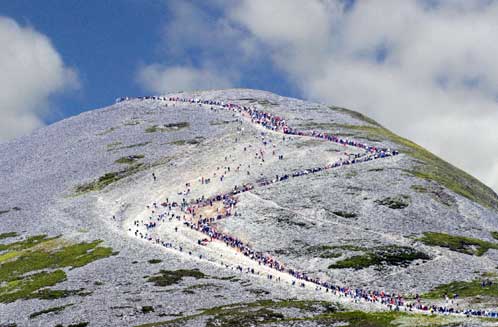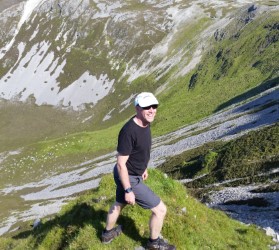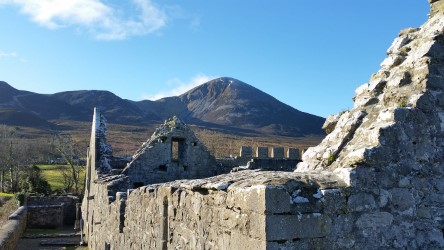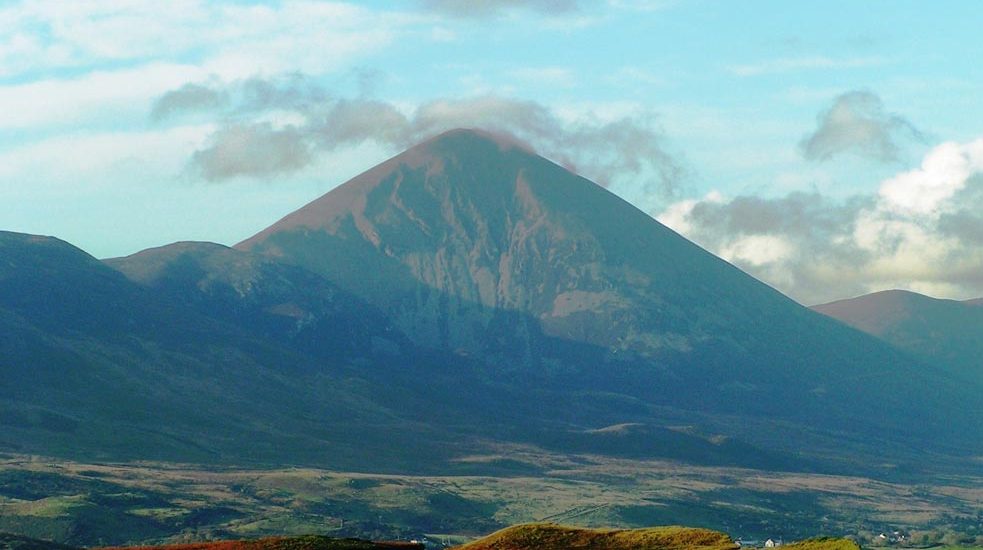Michael Cusack takes a critical look at the many controversial issues facing Croagh Patrick Mountain today. There’s the continued erosion caused by ever-growing numbers of climbers on the Reek (its nickname) and the inherent dangers that that brings. He asks who is actually responsible for Croagh Patrick as it is not a national park, and what needs to be done to protect the future of Ireland’s iconic holy mountain.
Michael is a returned Mayo native from the US and a guide with Reek Tours. He is also the author of Croagh Patrick and the Islands of Clew Bay – A Guide to the Edge of Europe.
Alarming Rates of Erosion…
In recent years, there has been much talk about the alarming rate of erosion on Croagh Patrick’s primary pilgrimage path. There is no doubt that the summit cone of the mountain has become difficult to negotiate for all but the most coordinated visitors. Today, it is not unusual to see people descending the ‘bad bend’ – a particularly steep stretch about three hundred vertical feet below the summit – on their backsides. Almost every day during the peak season just before and after Reek Sunday in July, the Mountain Rescue team and often the coastguard helicopter are summoned to the mountain as a result of a fall or some other mishap.
In 2013, a report carried out by Elfyn Jones of the British Mountaineering Council proposed major restorative works, as well as suggesting more formalised management and monitoring of traffic on the mountain. Jones found that upwards of €1.5m would have to be spent to preserve the main route up Ireland’s holiest mountain. Jones was quoted as saying that with the possible exception of Snowdon in Wales, ‘there cannot be many other sites where a relatively wild and natural mountain is climbed by so many inexperienced and ill-prepared walkers’. Jones estimated that 300 separate 500kg bags of stone would have to brought to the summit cone by helicopter to help make the path safer for visitors.
Tourist Magnet…
The importance of Croagh Patrick as a magnet for visitors cannot be underestimated. A survey conducted by the Westport Tourism Organisation (WTO) determined that of the reasons influencing people to choose Westport as a holiday destination, a remarkable 60.2% indicated that Croagh Patrick either greatly influenced or somewhat influenced their decision. Climbing the Reek ranked second only to the Greenway and Railway Walk as the most attractive outdoor activity for tourists in the Westport area.
Michael Ring, then Minister of State at the Department of Transport, Tourism and Sport, once described the mountain as “an integral part of our spiritual and cultural heritage and very important for tourism.” One Canadian sculptor, Timothy Schmalz, has even proposed erecting a 100-foot-high statue of Saint Patrick on top of the mountain. He was quoted as saying that “the whole Westport area is like an artist’s masterpiece that has been put in a dark closet. Wouldn’t it be fantastic if thousands of more people knew it existed?”

Michael Ring, then Minister of State at the Department of Transport, Tourism and Sport, once described the mountain as “an integral part of our spiritual and cultural heritage and very important for tourism.” One Canadian sculptor, Timothy Schmalz, has even proposed erecting a 100-foot-high statue of Saint Patrick on top of the mountain. He was quoted as saying that “the whole Westport area is like an artist’s masterpiece that has been put in a dark closet. Wouldn’t it be fantastic if thousands of more people knew it existed?”
There has been talk of closing the mountain altogether, or banning athletes who race up and down the peak. The former would be a drastic measure indeed, considering the enormous footfall of visitors to this beautiful peak each year. Recently, however, Mayo County Council’s head of environment was appointed to lead a Croagh Patrick Stakeholders group, whose aim is to manage the impact of growing numbers of recreational users on the mountain.
‘There cannot be many other sites where a relatively wild and natural mountain is climbed by so many inexperienced and ill-prepared walkers.’
This group recently created a dedicated map marking the pilgrimage route on the 764-metre-high mountain, new signage and information boards, as well as ‘counters’ to determine precise numbers using the sacred site. Perhaps more significantly, the group is appointing a consultant to design the conservation works. It is anticipated that the Department of Environment, Fáilte Ireland and Mayo County Council will fund the conservation project, which would also be supplemented by voluntary contributions from users.
Members of the clergy have also voiced their concerns about what is seen as the commercialization of Ireland’s holy mountain. Currently, the Reek is a focal point for some major events, including endurance tests like the Gael Force and Sea2Summit races. Father Frank Fahey of Ballintubber Abbey, who was instrumental in the restoration of what is called the Tochar Padraig or ‘Patrick’s Causeway’, as an ancient pilgrimage route from the abbey to the top of the mountain, was quoted as saying that Croagh Patrick should not be exploited in this way, and that the sacred dimension must be prioritised and emphasised.
Who Owns Croagh Patrick?
Yet even today there is debate and often confusion about who actually owns Croagh Patrick. The fact is that despite its global fame, this mountain is not a national park or world heritage site. In fact, it is not legally protected at all. The higher slopes are actually part of what is called commonage and thus owned by a number of local farmers, while the small oratory at the peak is owned by the Catholic Church.
Most of the pilgrim route is through two commonages, one with 46 shares and another with three shareholders. Elfyn Jones points out in his report that while there has been a very long tradition of access to the mountain from Murrisk there is no existing legal right of access on foot.
To complicate matters, the question of liability has been raised regarding those who are injured on the mountain. Earlier in 2016, a court upheld a claim by a walker on the Wicklow Way that reasonable care had not been taken to maintain a boardwalk in a safe condition and this failure was responsible for a gash to her right knee which required seven stitches.
The Irish National Parks and Wildlife Service (NPWS) was held liable for negligence and breach of duty and ordered to pay the hiker €40,000. The case is under appeal, but if upheld, this sets a precedent whereby any work performed on the summit cone to make it safer for pilgrims may become the responsibility of those who undertook the work in the first place and/or the ‘owners’ of the peak. While ‘totally at your own risk’ disclaimers are in place today, there is some question as to whether or not these would be upheld in an Irish court of law.
More recently, there has been talk that a recognised legal policy will be enacted meaning that anyone entering privately owned land, such as Croagh Patrick, will be taking responsibility for themselves, and that the landowners and the Mayo County Council will be indemnified. It is hoped that the Uplands Management Division of the Department of Arts, Heritage and Regional Development will provide a National Indemnity Scheme for Upland Areas as a matter of urgency.

For over twenty years, the Murrisk Development Association (MDA) have worked to maintain Croagh Patrick as a national site. This is a somewhat unique organisation as it works to upkeep the mountain as a tourist attraction on a voluntary basis. The South West Mayo Development Company, a government funded agency, has also helped with funding for projects in the area, such as the community centre at the foot of the mountain.
The official car park at the foot of the mountain in Murrisk is maintained by the Mayo County Council, who began charging visitors after refurbishing the area at a cost of 150,000 Euros several years ago. Revenue from the car park is currently shared between the county council and the MDA.
The fact that the mountain is commonage also raises other questions for those who are concerned about its future. In 1989, a concerted effort to open the mountain to gold mining was thwarted only by local opposition. No less than twenty-one prospecting companies were invited to bid on mining rights at the time. That seam of gold is still contained in at least 12 quartz veins on the mountain, which according to experts could produce 700,000 tons of ore and potentially over 300,000 troy ounces of gold.
Even today, over twenty-five years later, there is much chatter on the Internet about the prospect of revisiting gold mining. Local opinion was somewhat divided at the time, although the majority prevailed, and no doubt this is a matter that will come up for debate again in the future.
Other Approaches…
Croagh Patrick is a spectacular peak whose pilgrimage traditions go back thousands of years. Excavations in the area have revealed that it was one of the foremost ritual sites in all of Ireland long before the advent of Christianity. While the current ‘Pilgrims Path’ from Murrisk is the one used by the vast majority of visitors, it is by no means the only recognised access point to the mountain.

The Lecanvey Route, for example, is rarely used today, but once was part of the pilgrimage trail that led from Caher Island, near Inishturk, to the summit. In fact, this route is far more benign and less treacherous than the Murrisk route. Access, however, is somewhat more challenging. Unlike Murrisk, there is no designated car park and obvious line of sight to the summit. Those who visit all three ‘stations’ of Leacht Benain, The Summit, and Reilig Mhuire on the pilgrimage route will be familiar with this approach.
Some would also argue that Saint Patrick’s initial approach to the mountain would have been via what is now known as the Owenwee route, which is part of the Tochar Padraig starting at Ballintubber Abbey. This fascinating and historic route includes no less than thirteen stages and 113 stiles on its journey of over thirty kilometres to the summit.
The Mayo Mountain Rescue team use part of the Owenwee route as it affords easier access to the shoulder from their station. Then there is always the traverse from the east via the Western Way access point, or from the west via Ben Goram, which would have been part of the original route from Caher Island. However, the only routes that would avoid the most eroded parts of the summit cone are those from the west.
What is to be done?
One obvious, if expensive, solution to the problem of erosion, particularly on the summit cone of the mountain, is to adopt the model of paths in the MacGillicuddy Reeks in Kerry or even Diamond Hill in the Connemara National Park, which has gravel footpaths and flagstones all of the way up to and down from the summit. Being one of six national parks managed by the National Parks and Wildlife Service, the Connemara National Park receives government funding that is not applicable to Croagh Patrick, so the money for any such project would have to come from another source.
Elfyn Jones states in his report that if the landowners were agreeable, there could be options under the Planning Acts to declare the route a public right of way. This would put a responsibility on the local authority to then maintain the path in future years.
Another solution would be to utilize other access points to the mountain, such as Lecanvey, although as it stands, this would require some form of right of way access over private lands in the immediate area.
“The whole Westport area is like an artist’s masterpiece that has been put in a dark closet. Wouldn’t it be fantastic if thousands of more people knew it existed?”
There are growing calls to eliminate commercial events on Croagh Patrick, as many believe that much of the recent erosion has been exacerbated by competitive athletes running up and down the mountain. However, any such claims are currently considered ‘anecdotal’. There is also talk of banning visitors entirely from climbing above the statue of Saint Patrick over a period of time, in order to allow the peak to ‘repair itself’. This suggestion has been criticized by Failte Ireland, who labelled any such action as ‘disastrous’ for tourism in the area.
The final solution may be a combination of all of these considerations, but for now the fate of Croagh Patrick as a magnet for visitors from all over the planet is, as they say, ‘in the lap of the gods’.
Michael Cusack is a guide with Reek Tours and the author of Croagh Patrick and the Islands of Clew Bay – A Guide to the Edge of Europe.
For more information, please go to http://thereek.com/

